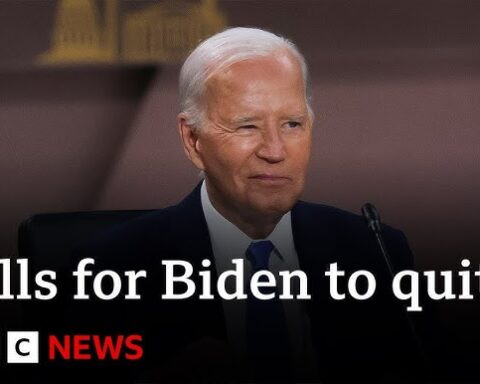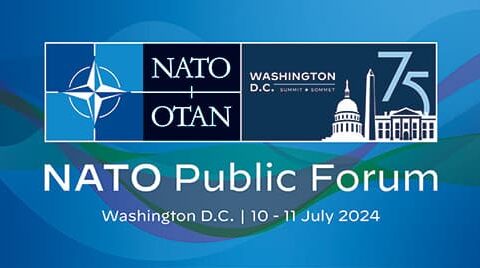It has to be said that, if there is any one defining image that seems to capture the whole saga of the War in Afghanistan, it is the much-replayed image of people clinging desperately and fruitlessly to the underside of a departing US plane.
It wouldn’t surprise me if, years from now, this remains the defining visual – the bitter coda – to NATO and the West’s two decades of quagmire in the ‘graveyard of empires’.
If Iraq could be distilled down to the somewhat farcical image of Bush standing before the ‘Mission Accomplished’ sign, then the sight of terrified and abandoned Afghan allies of Western occupiers trying in vein to literally cling to the departing aircraft (and, metaphorically, to the empty promises) of their foreign guests seems to capture everything: the sense of failure, the sense of hopelessness, the sense of betrayal, and, perhaps finally, the sense of inevitability.
Actually, in terms of the Iraq War’s defining image, most pro-war and neo-imperialist cheerleaders would prefer the lasting image to be that of Saddam Hussein‘s statue being toppled by the Iraqi crowd. But that ship has long sailed: and reality has not allowed that to be or to remain the definitive visual of the Iraq War, much as the Neo-Cons would wish it so.
And so too with Afghanistan, when years have passed and this endless campaign is being reflected on by analysts, it’s the chaos at the Kabul Airport – and in particular the memory of those people clinging to that plane – that will linger in people’s minds.
I already posted a long article on the broader questions of the 20 year Afghanistan campaign back in July: looking at why the war happened and trying to explore various important aspects of the saga, including the heroin trade. In this piece, let’s focus purely on the events of the last few weeks. There are some burning questions – and very odd elements – that need to be addressed.
In short, there are some things about the last few weeks’ events that don’t add up.
To start with, at the basic level, it’s the messiness, the sheer incompetence, and the bitterness, of this ending that will define the entire two decade misadventure: an untimely reminder of the very real but often overlooked human element to all of this obscure geopolitical adventuring and foreign policy think-tanking.
Unfortunately for him, Joe Biden will be remembered too as the man who presided over this undignified and messy epilogue. Not that Biden is anything less than bumbling and incompetent, but this mess in Afghanistan was not his creation. For that, the Bush gang, Blair and NATO need to be more squarely under scrutiny.
And Biden’s predecessor, Donald Trump, was actually the one who set this Afghan withdrawal in motion: which included American negotiations with the Taliban in early 2020, promising US withdrawal from the country by May 2021.
This being said, Biden went beyond bumbling and incompetent in the days after the start of the chaotic US exit and actually came across as tone-deaf, uncaring and even callous. His speech on the night Kabul fell to the Taliban was so badly off-the-mark that you have to wonder if it had even been checked by speech writers.
For one thing, Biden’s blaming the Afghan forces for not standing up to the Taliban, or for fleeing in some cases, is very unfair. Firstly, the Afghan forces had spent almost twenty years entirely dependent on NATO support, only to suddenly have it yanked away from them as the Taliban were rampaging all over the country. Secondly, how on earth were the Afghan fighters supposed to maintain morale and fight with conviction when they knew that (1) the Americans had already signed a deal with the Taliban in 2020, (2) the Afghan President Ashraf Ghani literally *fled the country* at the first sign of Kabul falling, and (3) the Taliban is generally expected to execute enemy fighters and commanders when they capture them.
Honestly, if you were one of those Afghan forces and you felt abandoned by NATO and the US, you knew the Americans had made a deal with the Taliban already, and you just watched your own president flee to another country… would you really have the morale and conviction to keep fighting?
And… speaking of the agreements made between the Trump administration and the Taliban (and then taken up by the Biden administration), one can’t help but ask: how could the US negotiate deals with the Taliban regarding Afghanistan’s future while at the same time *claim* to be supporting and empowering the Afghan government and its forces? If the US believed in the Afghan government’s ability to survive or its readiness to stand on its own two feet, why were they negotiating with the Taliban?
And how can Biden blame the Afghan forces for not fighting hard enough, when the Americans themselves were having their actions dictated by the Taliban – the very same Taliban that, weeks before the fall of Kabul, were already executing Afghan security officers? It makes no sense.
None of this bizarre transfer of power makes any sense. Unless some very complex 4d chess is being played, it reads like nothing less than total US/NATO capitulation: thus rendering the entire two decades of Afghan operations since 9/11 a total failure.
And, as I argued in the Afghanistan piece from a few weeks ago, pure logic says that if the Afghan forces had been well trained, equipped and prepared by their foreign sponsors, they wouldn’t have collapsed so quickly. Likewise if the Afghan state infrastructure and its institutions had been well established and secured by its foreign patrons (who had twenty years), the Taliban couldn’t have taken over with that kind of almost comedic speed.
The fact that the US was negotiating with the Taliban surely, by definition, means they didn’t have much faith in the Afghan government’s ability to succeed. But if they didn’t have any conviction in the fledgling Afghan state, then why did the US commit to a complete withdrawal from Afghanistan?
Unless… they entirely *expected* the Taliban to take over and were simply okay with it.
Again, I almost wish there *is* some kind of 4D chess being played: but it doesn’t look like it right now. The days and days of chaos and desperation at the airport in Kabul seem to be suggestive, again, of sheer incompetence.
And the whole thing gets stranger the more and more you look at it.
The deadly attack on that same airport by ‘ISIS K’ (which sounds like an Islamist breakfast cereal) also reinforces this sense of hopeless chaos: though, at the same time, the airport attack itself seemed strange. It’s odd that Biden himself mentioned the likelihood of an ISIS attack on the airport just a day or two before the attack happened: if the US, and presumably the Taliban, had warning or foreknowledge of this attack on the airport, shouldn’t it have been stoppable?
Maybe I’m being unfair there: a result of years of examining apparent false-flag terror incidents. Maybe ‘ISIS K’ just got lucky.
But the ‘ISIS’ brand itself is the child of US/Western interference in Iraq, Libya and Syria: and now one of its offshoots is bombing civilians trying to flee another country the US and its allies have ballsed up in. It’s also a little stomach-turning to see Israeli Mossad asset Rita Katz showing up again as an expert on the subject. Katz’s organisation, the SITE Intelligence group, has been responsible for most of the ISIS propaganda videos and releases from 2014 onwards: and she was, naturally, on hand to ‘translate’ ‘ISIS K”s statements in relation to the Kabul airport bombing.
Correction: Earlier I posted a video calling it the second blast at #Kabulairport. This was in fact not a video from Kabul, but rather footage from Gaza. The video has been removed and Tweet has been deleted.
— Rita Katz (@Rita_Katz) August 26, 2021
She also, on August 26th, tweeted an image of a bomb attack in Gaza and presented it as a scene from the Kabul airport attack: which she was forced to correct later.
Whatever’s going to happen with this ‘ISIS’ offshoot in Khorosan remains to be seen: but the fact that it views the Taliban as an enemy and that the Taliban views ISIS as ‘unislamic’, too extreme and essentially a foreign creation, lends itself to the possibility of ‘ISIS K’ being a foreign-backed agent-provocateur of some description.
In that specific context, the Taliban are pretty much the Good Guys in the equation – which is rather extraordinary.
Then again, the Taliban itself is generally supported by foreign entities and has been since its beginnings. And, for example, the Haqqani Network that is deeply connected with the present Taliban leadership, and which has been blacklisted as a terrorist group by the US and UK among others (and banned in Pakistan), has also been previously aided by the CIA, the Pakistaini ISI and others, as well as receiving funding from wealthy donors in the Persian Gulf States.
It is very difficult to believe that any of what has transpired has been unforeseen.
For example, the Afghan Taliban’s current leader, Mullah Baradar, had actually been in prison in Pakistan up until late 2018: he was released due to US intercession via Qatar. The Taliban in fact had only set up its offices in Doha at the request of the US, we are told. “This release has come at a time when the United States has started directly talking to Taliban, it seems the timing [for this release] is really important,” a Pakistani analyst told Al Jazeera at the time.
This was happening during the Trump administration, when former CIA man Mike Pompeo was fronting the foreign policy activities.
Other high-level Taliban figures were also released from prison. Further, the US had been pushing the Afghan government, right up until August 3rd, to release ‘thousands’ of Taliban fighters from Afghan prisons (as reported by the Wall Street Journal here).
Even stranger, it had been admitted that ‘thousands of ISIS K fighters’ have also been released from prisons by the Taliban themselves. Which doesn’t seem to fit the narrative at all.
But what does anymore?
Why were ISIS fighters in Afghanistan being set free? And why, prior to all of this, were Taliban fighters and leaders – some of whom were in jail presumably for valid reasons – being set free through negotiations that included the Americans?
But… I’ve almost given up trying to make sense of it anymore.
Even more puzzling than all of that is this: the Taliban had actually given the Americans the option of retaining control of *all* of Kabul – but the US had turned this offer down! According to the Washington Post: ‘In a hastily arranged in-person meeting, senior U.S. military leaders in Doha — including McKenzie, the commander of U.S. Central Command — spoke with Abdul Ghani Baradar, head of the Taliban’s political wing.“We have a problem,” Baradar said, according to the U.S. official. “We have two options to deal with it: You [the United States military] take responsibility for securing Kabul or you have to allow us to do it…”
Instead, the US decided it only wanted control of the airport – and the Taliban should have control of the city. But if the US had taken up the Taliban’s offer and kept control of the whole city until the deadline, surely it would’ve been much easier to get everyone out in an orderly manner – Americans and allied Afghans alike. There would’ve been no armed Taliban intimidating people or controlling access to the airport. And there may not have been any ISIS security breach resulting in so many deaths either.
It looks as if they were in a real hurry to hand control over to the Taliban – regardless of the option to retain more control of the evacuation and the conditions. Why? Why did the US make it even harder for themselves and everyone else?
And, shockingly, there’s also reason to wonder if a mass casualty event at the airport was somehow and for some reason *desired*: the BBC, via its Newsnight flagship programme, has revealed that ‘UK officials instructed Afghans to go to the Abbey Gate entrance to Kabul airport hours before Thursday’s suicide bombing there, the BBC has learned… Emails seen by Newsnight show that even though the UK and US deemed a threat to the airport to be imminent, the British embassy told people to “use the Abbey Gate.’
Afghans eligible for evacuation on account of their work with the British forces were apparently being directed right into the danger zone, even though the ISIS attack was entirely expected.
The BBC report continues, ‘One Afghan woman who worked for the British embassy in Kabul said the UK advice to people wanting to leave the country that day was “conflicting and confusing”… She said: “You should not be calling people to the gate when you know this situation. “I’m surprised because if I was responsible, I would not be asking people to risk their lives. [The UK government] were not replying to my emails.…’
Again, as with all of these questions and issues I’m raising here: what is it – incompetence or obscure design? Genuine loss of control and poor planning… or some kind of organised chaos? I don’t know what the answer is.
But wait, there’s more.
According to multiple eyewitness reports, many of the almost 200 civilians killed in the apparent ISIS K bombing of the airport were killed not by the bomb… but by US troops. ‘On Saturday, a BBC reporter named Secunder Kermani posted a video on Twitter, in which Afghan civilians were interviewed at the Kabul airport. “Many we spoke to, including eyewitnesses, said significant numbers of those killed were shot dead by U.S. forces in the panic after the blast”…’
Other eyewitnesses claimed that US and Turkish troops were firing on people from a tower.
So what the hell actually happened?
Okay, I’m done with this for now. If I carry on any further, I’ll need to be prescribed anti-depressants or something.
Actually, no, let’s do one more. There’s this: the Taliban is believed to have gained access to databases and vast amounts of personal information on Afghan citizens, which will allow them to target various individuals.
As Sky News reports, ‘The Taliban has gained access to vast amounts of personal information through former US military and Afghan government databases that could allow them to target civilians… It would be the first time the group has acquired the personal information of Afghan civilians on such a scale… And with reports that documents identifying job applicants and Afghan workers were left outside the British embassy, the threat of identifying information falling into the wrong hands is more real than ever.‘
In FIRST PLATOON, I chronicle the Pentagon's Panopticon-like biometrics program.
The one designed to capture BIOMETRIC data from 80% of all Afghan citizens.
Here's what capturing DNA from a random citizen (no probable cause, not suspected of a crime) looks like👇. pic.twitter.com/vYmW5maEOO
— Annie Jacobsen (@AnnieJacobsen) August 24, 2021
This includes facial recognition and biometric data, stemming from American technology that was aimed at gathering biometric data on 80% of the Afghan population: initially targeting criminals and insurgents, but later developed to encompass everyone, including the identification of Afghans who worked for the US, British or NATO forces.
In other words, the Taliban now has access to mass surveillance data on most of the population – and can presumably begin going after various individuals. Perfect.
Curiously, this appears to be another thing the US and NATO didn’t think about – or care about – when arranging the transfer of power to the Taliban.
As noted in the article from a few weeks back, the US has also failed to remove or destroy various technologies, weapons, vehicles and other resources at its abandoned bases: allowing the Taliban to seize those bases and take possession of everything the US military left behind.
A mistake? An oversight? Or something else?
I ask that again here because the US has shown that it can and will destroy things when it wants to: curiously, the CIA carried out a controlled demolition of its base just outside Kabul on the same day as the apparent ISIS K attack on the Kabul Airport. Apparently this was to prevent sensitive information falling into the hands of the Taliban, which could be used to target Afghans who worked with the NATO forces.
Fair enough: but how come they were willing and able to destroy the CIA base, but not the various military bases and treasure-troves of weapons and hardware that the Taliban captured? And why weren’t they as concerned about the databases and biometric data that is going to leave scores of Afghans vulnerable?
Was there something else in the CIA base that they were worried about? I guess we’ll never know.
Alright, I really am done now.
Lastly, let’s please dispel the misperception that Afghanistan has always been a backwards, chaotic country living in stone age conditions and that only an organisation like the Taliban can run it. This widely held view of the country is an insult to Afghans and their history.
Afghanistan in the 60s and 70s was not like this: as these types of old video compilations show. Like Iran before the Ayatollahs (and let’s remember that it was the British/American overthrow of the secular Iranian government in the 1950s that paved the way for the Ayatollahs), Kabul and other parts of Afghanistan were relatively progressive and forward-looking. Women in general had no restrictions imposed on them, universities and places of learning were thriving, and Afghanistan was even part of the hippy trail, drawing Western travellers and pilgrims.
It was the Cold War, the Soviet invasion, and the subsequent US-backed jihadist campaign that created the societal conditions that we now see in Afghanistan. If the US can be (rightly or wrongly) criticised for empowering a zealous holy war mentality in Afghanistan and thus creating, in the end, the Taliban, the Soviets are equally to blame – perhaps even more so – for the religious fundamentalism that has dominated the country since then.
The Soviet repression of religion and worship in Afghanistan was brutal: in some cases, Afghans were arrested and even killed simply for trying to carry out their traditional prayers. No wonder the anti-Soviet fighters became radical Islamists – their religion itself was being violently suppressed by foreign non-believers.
If Afghans had developed on their own, following their own destinies, instead of being a pawn or prize in the games of foreign powers, it’s likely it would be a completely different country and society at this point in time. Something much more connected to the more open and developing Afghanistan of the 60s and 70s.
Afghan people, at least those who didn’t want a return to the Taliban days, were given false hope and sold false promises by the US, NATO and the international community: as well as by corrupt and weak-willed people in their own government institutions.
All hail the conquering Taliban. Hey, you know what? They’re probably not even the worst case scenario.
More: ‘From the Heroin Trade to Covert State Sponsors: What was the Point of 20 Years in Afghanistan?‘





Every specific that you questioned is valid. The burning question is, “What the hell was the US, Inc. doing there?” It’s a long-standing well-know fact that W was following in HB’s footsteps. Weapons of mass destruction, false. W’s declaring was on “terrism” was not unlike Raygun’s war on drugs. Complete, utter horseshit… but the See Eye A had a good run exploiting the poppy fields. Their black-ops accounts are flush, and then some. Expecting righteousness from the largest organized criminal enterprise in the world, the US government, is akin to planning to live forever. I lost any optimism upon realizing that .gov is dysfunctional for a reason. It is interesting to watch, almost comical.
Ouff
Difficult to realize people falling from planes …
Will reread but it’s already good what I’m reading.
Ah .. another article that I feel I will translate.
Tk you S. Awan
Bless y
Thanks Neilly, you’re always welcome.
I have read and reread.
You know how to express ideas that others find it difficult to explain in a different but pleasant style (maybe for me, maybe this is your British style with something else. For now, I am gradually discovering this kind).
Happy is he who is endowed with logical reasoning and reasoned emotion (This world needs this).
A kind of article that we would like to read more often on sites that target the general public.
Merci S. Awan
Bless y
https://ligbuzz.freemindaily.com/2021/09/afghanistan-une-image-determinante-et-plusieurs-questions.html
This comment isn’t really about Afghanistan, per se, but I had a thought when you talked about the Pentagon’s biometric database of 80%+ of Afghan citizens…maybe it was the accompanying photograph of an Afghan being swabbed with a large cottonbud. But what if all these deliberately invasive (ritualistic oral and nasal violations) “covid tests” are really nothing of the sort? What if governments are actually building biometric databases right now to go with their “vaccine passports”? What if these “tests” are really the collection of citizens’ DNA without their consent. Apologies for the off-topic comment.
Hi Rod Zilla. Yes, I have to admit that thought did occur to me too: actually it’s something my Mum, of all people, brought up with me a while ago. Scary thought.